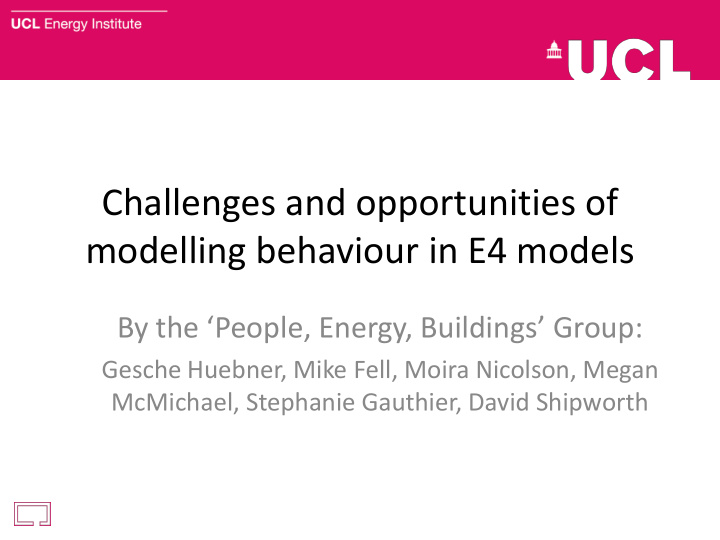



Challenges and opportunities of modelling behaviour in E4 models By the ‘People, Energy, Buildings’ Group: Gesche Huebner, Mike Fell, Moira Nicolson, Megan McMichael, Stephanie Gauthier, David Shipworth
Four main challenges 1. Limited understanding of ‘ behaviour ’ 2. Lack of ‘theories’ with substantial explanatory power of behaviour 3. Lack of high quality data relevant to behaviour 4. Huge complexity of the physical processes through which behaviour is translated into changes in energy demand
1. What is behaviour? - Definitions • The way in which an animal or person behaves in response to a particular situation or stimulus (Oxford Online Dictionary) • Environmentally significant behaviour: the extent to which it changes the availability of material or energy from the environment or alters the structure and dynamics of ecosystems or the biosphere itself (Stern, 2000) • Two types of behaviour: curtailment versus one-off behaviour (Stern & Gardner, 1981) • Everything that isn’t buildings (Seligman et al., 1978)
1. What is behaviour? - Models Attitude toward behaviour Subjective Intention Behaviour norm Perceived behavioural control Theory of Planned Behaviour (Ajzen, 1991)
1. What is behaviour? - Models Personal Awareness Responsibility Behaviour norm Norm Activation Model (Schwartz, 1977) (Graphical representation after Onwezen et al., 2013)
1. What is behaviour? - Models Attitude Facilitating conditions Social Intention factors Behaviour Affect Habits Theory of Interpersonal Behaviour (Triandis 1977)
2. Lack of explanatory power • TPB explains 25 – 35% of the variability in behaviour (e.g. Ajzen, 1991) • VBN theory explains 19% to 35% of the variability in behaviour (Stern et al., 1999) • Example of (self-reported) travelling choice (Bamberg & Schmidt, 2003) – TPB: Intention and the control beliefs explain 45% variance of car use – TIP: car use habit and intention explain 51% variance of car use – Norm-activation model: personal norm explains 14% of variance in car use
2. Lack of explanatory power – energy consumption 40 In total, we can only 30 explain 42% of 20 adj. R 2 10 variability in domestic 0 energy consumption. (Huebner et al., 2015) • Behaviour plays tiny role Model – Also: neither variables of ‘Theory of Planned Behaviour’ nor of the norm-activation model explain energy consumption (Abrahamse & Steg, 2009) – But: one-off behaviours modelled as building variables!
3. Data issues – Variability Huge variability between homes (N = 275 homes, average winter temperature). Is the mean sufficient in representing the data? e.g. maximum more important? Huge variability within a home (N = 92 winter days). (Huebner et al., 2013)
3. Data issues – Measurement • Internal temperature 1.7m P01 proxy for demand P02 P03 P04 temperature & P05 P06 P07 1.1m calculation of rebound P08 Monitoring heights P09 P10 effect • But: not uniformly 0.6m distributed in space – Impact of measurement 0.1m height and location 10 15 20 25 Living Room - Temperature [oC] (Gauthier & Shipworth, 2014)
3. Data issue – Data sources/ methods • Different data sources / methods can give different results. – e.g. self-report versus observed data on thermal discomfort actions (Gauthier & Shipworth, 2015)
3. Data issues – Data sources / methods • Different data sources / methods can give different results. – e.g. • Focus groups showed people thought they would lose personal control under ‘direct load control’ (i.e. remote control by third parties for purposes of demand-side response) (Fell et al., 2014) • Representative survey showed people thought they would have more control with a direct load control tariff than under time of use pricing (Fell et al., under review)
3. Data issues – Non-availability • For many new technologies, we can only assess stated preferences (“I would sign up to a Time of Use Tariff”) but not revealed preferences (‘number of people signing up to Time of Use Tariff’) – Product / infrastructure just not available • Problem: How well do stated preferences translate in actual demand? .25 .2 .15 .1 .05 0 0 1 2 3 4 5 6 Willingness to switch to Off-Peak 3-Rate Tariff on 7 point Likert scale (Nicolson et al., under review)
3. How do stated preferences transfer into actual demand – Green Deal • “Central assumption” behind the Green Deal (UK Government’s flagship energy efficiency programme) was public take-up rates • Public take up rates were calculated using results from choice modelling of main energy efficiency measures (DECC, 2012)
4. How does behaviour relate to energy demand? • Complex physical processes translate behaviour into changes in energy demand • The same behaviour in different contexts could have very different energy implications – Even if we knew the temperature set-point of an occupant, we wouldn’t know the implications for energy use, unless we knew about building & technology factors, climate, and other behaviours such as window opening Cannot model behaviour in isolation
What can social science do? • Grow understanding of behaviour through more & better data – E.g. reduce measurement errors, representative samples, experimental research to make causal statements (RCTs) • E.g. LUKES project as part of CEE (Cooper et al., 2014) • Communicate & advice on best practice – Show the limits of our understanding of behaviour – Identify most appropriate data sources for given purposes – Quantify error margins and variability – Give a ‘realistic’ estimate about behaviour change potential and associated costs • Grow as a discipline – Understand the relationship between hypothetical and actual behaviour – Bridge technology, buildings, people – Increase conceptual clarity – Be less tribal
Recommend
More recommend